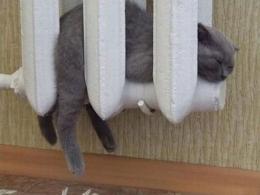Search
Login
Choosing heating radiators for replacement or installation
In Russia, despite the development of electric heating, most of the buildings are heated by water heaters. In this article, we will try to justify the choice of a radiator when replacing old models or installing radiators in new housing.
Content
- General information about radiators video
- Heat dissipation of radiators video
- Cast Iron Radiators
- Steel radiators
- Aluminum radiators
- Bimetal radiators
General information about radiators
When installing heating, radiators are installed everywhere, and the radiator is a serious equipment.
When choosing this equipment, it is necessary to take into account many different nuances, as the wrong choice leads to big problems.
This is not only discomfort, but also the likelihood of flooding your living space and the living space of neighbors from below.
The legislation of our country forbids changing installed radiators without coordination with the organization that designed the building.
The radiator is an important device of the heating system, since it is in the system, it must meet its requirements for hydraulics, strength, power.
An error when choosing a radiator can lead to hydraulic imbalance of the system.
In our country, in apartment buildings, central heating with open systems is used.
Oxygen freely enters such a system; it leads to the corrosive activity of radiators.
A significant part of heating devices that are designed to work in closed systems with membrane expansion tanks, which does not allow oxygen from the air to enter the coolant, enters our modern market.
In recent years, apartment buildings have used closed circuits in which heat is received through heat exchangers rather than through central networks.
In addition to oxygen, it is necessary to take into account the pH of the coolant, hazardous particles of sludge (they scratch the device from the inside and clog the fittings).
An important factor when choosing a radiator is the coolant pressure at which it can work, it is necessary to take into account surges (hydraulic shocks), take into account the working and test pressure (in Russia, the test pressure is 1.5% of the working one).
Manufacturers can indicate the fracture pressure, it must be borne in mind that the fittings for heating systems are designed to work at 10-15 atm.
Given all these nuances, you can purchase the right radiator.
Heat dissipation of radiators
Each room requires its own radiator, which must have a certain power or heat dissipation. The heat transfer of the radiator depends on the installation location and how it is connected.
Sectional radiators have the heat transfer of each section (it is customary to indicate the heat transfer of one section), the power of the entire device is indicated for panel radiators.
The heat flux consists of convective and radiant heat.
Convective heat involves heating the air, gradually circulating around the room, it fills it.
Radiant heat is the infrared waves emitted from the surface of a radiator.
The convective fraction of heat is more than half the heat flux of the radiator, higher for models with developed finning (aluminum radiators, bimetallic, panel with finning).
For tubular radiators and panel radiators without fins, the convective fraction is lower.
The radiator is not only a heat source, but also a thermal curtain in front of the window opening, which is why heating devices need to be placed under the windows.
It is important! According to building codes, the radiator must cover at least 50% of the width of the window opening.
If the window sill is long, and the radiator is much shorter, then there is a lot of space on the sides of the radiator, the glass windows in these places emit cold inside the room.
It is important! Exit - you can install radiators with less powerful sections, but with a large number of them.
Cast Iron Radiators
Such radiators have long been familiar to almost everyone.
For many decades they have been working properly.
Cast iron is not subject to corrosion.
But when choosing such radiators, pay attention to the strength characteristics.
Basically, such radiators are designed to work in heating systems with low pressure.
Due to the high inertia, cast iron slowly heats up and slowly cools, therefore it does not fit well with thermostatic equipment.
It turns out the alternation of cold and heat instead of soft maintaining a comfortable temperature.
In addition, such radiators have enormous weight and not every wall can withstand it, therefore models with legs are produced.
Currently, retro-made radiators are widely used.
Steel radiators
These radiators have their advantages and disadvantages, low inertia, so all radiators can be equipped with thermostatic valves to adjust the temperature in the room.
Steel is more ductile, more resistant to deformation due to pressure, easy to weld.
Disadvantage. It is easily susceptible to corrosion, if there is oxygen in the water, it can rust right through the season.
Steel radiators are tubular and panel.
Tubular radiators have been known for a long time, sectional tubular radiators are more common.
Due to the large volume of sections, tubular models are widely used for low-temperature heating.
These are mainly symmetrical models, can be installed either side to the wall, they are easy to paint and keep clean.
Panel radiators are produced, they consist of two rectangular sheets of steel, are connected by spot welding.
Aluminum radiators
Aluminum radiators can consist of separate sections or of blocks; sections are connected using steel nipples.
Cast and extrusion radiators are available.
Cast are strong enough, withstand pressure above 16 atm.
Extrusion radiators are made by extruding softened aluminum through openings of a certain shape, and can operate at pressures above 20 atm.
These batteries are more expensive than cast.
It is important! Aluminum radiators have thin walls at the junction points and can crack when severely impacted.
Aluminum has high thermal conductivity and low inertia, goes well with temperature-controlled fittings
Important! The quality of the coolant is of great importance, since in alkaline water, aluminum reacts with the coolant, forms hydrogen, if it is not etched, the radiator will break.
Conclusion - in the first year of service of the radiator, it is necessary to bleed air from it.
In a closed heating system with a coolant having pH7-8, protected from water shocks - the best option for using aluminum radiators.
Bimetal radiators
Outwardly, they practically do not differ from aluminum radiators, since they came from aluminum devices, but appeared much later.
Widespread in Europe, in Russia, due to high pressure and water hammer in central heating systems, poor quality coolant composition, there were problems with operation.
Manufacturers reinforced the vertical channels of the sections, for which steel pipes were placed in the channels.
The result is more steady water hammer and high working pressure.
Such radiators are also called semi-bimetal.
Important! The coolant for such radiators must have a pH8.





